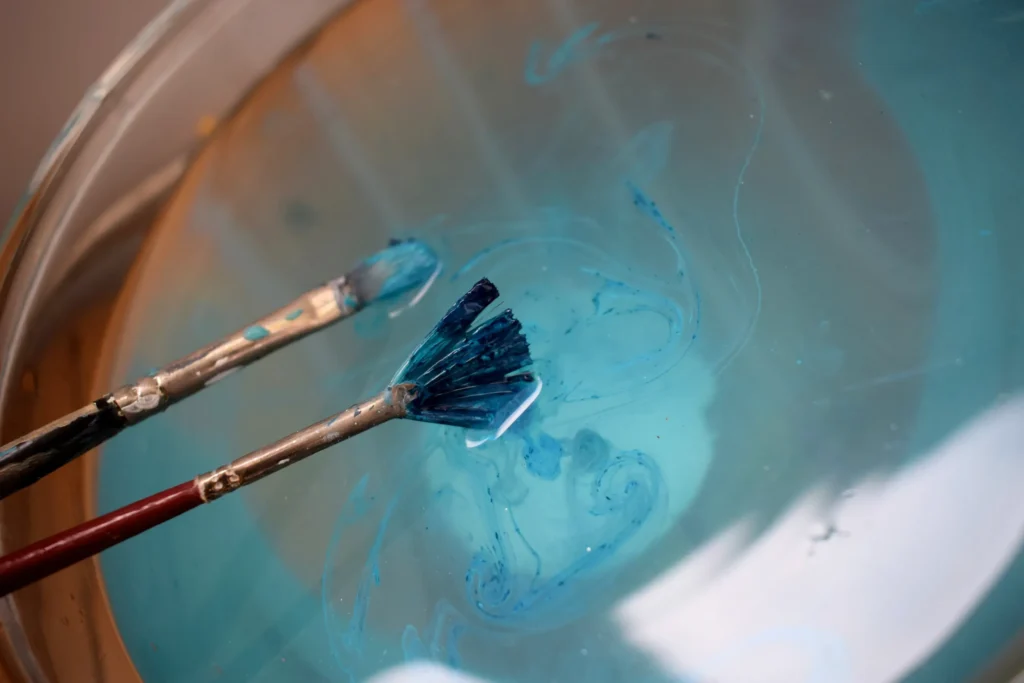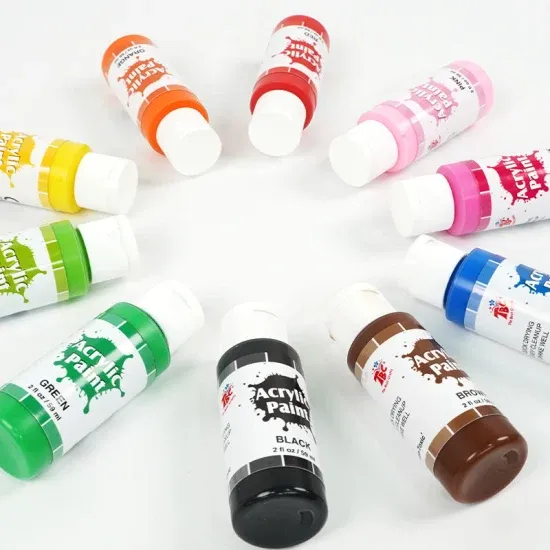Acrylic paint has long been a favorite medium for artists due to its versatility and vibrant colors. But have you ever wondered if this popular Acrylic paint water soluble?
Acrylic paint’s unique ability to be manipulated with water blurs the lines between traditional oil and watercolor painting techniques, making it an intriguing medium for artists seeking versatility.
Acrylic paint water soluble Nature
Acrylic paint water-soluble nature opens up a world of creative possibilities in depicting the beauty of nature.
Artists can blend and layer colors to create stunning landscapes, vibrant florals, and serene seascapes with remarkable depth and texture. The medium allows for both precision and spontaneity, making it ideal for capturing the organic fluidity of natural elements.
Contrasting textures
One fresh perspective on using acrylic paint to depict nature is through experimenting with contrasting textures. By employing various techniques such as stippling, dry brushing, or impasto, artists can convey the tactile qualities of bark, leaves, or petals with astonishing realism.
Fast-drying property
Acrylic paint’s fast-drying property enables artists to capture fleeting moments in nature—such as the play of light on foliage or the movement of waves—by working quickly with bold brushstrokes. The resulting dynamic compositions evoke a sense of immediacy and energy that mirrors the ever-changing essence of the outdoors.

Is Acrylic paint water-based?
Acrylic paint is often mistaken for being a purely water-based medium due to its easy clean-up and fast drying time. While it may seem like water would be the perfect solvent, acrylic paint is actually composed of pigment suspended in an acrylic polymer emulsion, meaning that it becomes water-resistant when dried. This does not mean it’s entirely waterproof.
Unlike oil paints, which are oil-based and inherently hydrophobic, acrylic can still be reactivated with water after drying if not properly sealed.
Its ability to blend with both water and various mediums allows for a wide range of techniques that cater to different styles and preferences.
Being water-soluble during application makes it an appealing option for those who prefer easier clean-up without sacrificing vibrant color intensity or durability once dry.
The nature of acrylic paint as a pseudo-water-based medium challenges traditional definitions and expands possibilities for creative expression in the art world.

Does Acrylic Paint dissolve in water?
The answer is not a simple yes or no, as it depends on various factors
Acrylic Polymer Emulsion
Acrylic paint is made from pigment suspended in an acrylic polymer emulsion, which means it is water-soluble when wet but becomes water-resistant once dried.
This unique property allows artists to manipulate the paint with water while working and then enjoy the permanent results after the paint dries.

Effects of Water Medium on Acrylic Paint
It’s worth noting that while acrylic paint can be thinned with water for a more translucent effect, using too much water can dilute the pigments and weaken the overall adhesion of the paint.
Some acrylic paints are labeled as water resistant or waterproof, meaning they may not dissolve completely in water even when wet. While acrylic paint may appear to dissolve in water when wet, its long-term resistance to moisture sets it apart from traditional watercolor paints.
How to Thin Acrylic Paint with water?
Acrylic paint is a versatile medium that can be easily thinned with water to achieve different effects and consistency.
Process
- The process of thinning acrylic paint with water involves adding small amounts of water to the paint until the desired consistency is reached.
- This allows for smoother brushstrokes, easier blending, and the creation of translucent layers.
- One important thing to keep in mind when thinning acrylic paint with water is to start with a small amount of water and gradually add more as needed.
- This helps you maintain control over the consistency of the paint, ensuring that it doesn’t become too runny or lose its vibrancy.
- Using a spray bottle to mist your palette and painting surface can help keep the paint workable for longer periods, especially in dry climates.
- It’s also worth noting that while thinning acrylic paint with water makes it more fluid and easier to work with, there are limits to how much water can be added before affecting its stability and coverage.
How to thin acrylic paint for wood?
When it comes to thinning acrylic paint for wood, water is your best friend. Since acrylic paint water soluble, adding water is an effective way to make the paint more transparent and easily absorbed by the wood surface.
Acrylic paint thinning with Water
Start by pouring a small amount of water into a separate container, then gradually mix it into your acrylic paint until you reach the desired consistency. Remember to add the water slowly and mix thoroughly to avoid over-thinning the paint.
Matte or Gel medium
Another option for thinning acrylic paint for wood is using a matte or gel medium. These mediums not only thin down the paint but also provide additional texture and body to the finished work.
Simply mix in a small amount of medium with your acrylic paint before applying it on the wood surface. This method allows for better control over the viscosity of the paint while maintaining its adhesive properties on wood.
Experimenting with different ratios of water and medium can give you a range of effects when working with acrylic paints on wood.

How is water based acrylic paint superior over oil based paint?
Water-based acrylic paint offers several advantages over oil-based paint, making it a superior choice for many artists and DIY enthusiasts.
Fast drying time,
One significant benefit of acrylic paint is its fast drying time, allowing artists to work more quickly and with greater flexibility.
Adhere to a wide range of surfaces
Acrylic paint is known for its versatility and ability to adhere to a wide range of surfaces, including canvas, wood, paper, and fabric. This makes it an ideal choice for mixed media projects and indoor or outdoor applications.

Emits fewer fumes
Water-based acrylic paint emits fewer fumes compared to oil-based alternatives, making it a safer option for artists working in enclosed spaces.
Quick cleanup
As Acrylic paint Water soluble, quick cleanup with soap and water also makes it more convenient than dealing with harsh solvents required for oil-based paints.

Waterproof and resilient against cracking
Another key advantage of acrylic paint is its flexibility; once dried, the colors are waterproof and resilient against cracking or yellowing over time—prolonging the lifespan of the artwork.
These qualities make water-based acrylic paint a compelling choice for both professional artists and hobbyists seeking high-quality results without sacrificing practicality or long-term durability.
Water based Acrylic Paints on Fabric
One advantage of using water-based acrylic paint on fabric is the wide range of colors and finishes available.
With acrylic paints, you have access to an extensive palette of vibrant hues as well as metallics, neons, and even glow-in-the-dark options.
Water-based acrylics are quick-drying and offer good colorfastness when properly applied to fabric. This makes them an attractive choice for artists and crafters looking to add unique designs or illustrations to their textiles.

Apply Acrylic paint water soluble on Fabric with right additives and techniques
It’s important to note that while water-based acrylic paint can be used over fabric with the right additives and techniques, it may not provide the same level of durability or washability as dedicated fabric paints.
When using acrylics on fabric, it’s crucial to follow the manufacturer’s instructions for preparing the surface and heat setting the finished design to ensure longevity. While using water-based acrylic paint over fabric offers creative possibilities and versatility in color choices, it requires careful consideration of materials and methods to achieve optimal results.
Can we Use Water based acrylic paint over Fabric?

Water-based acrylic paint is a versatile medium that can be used on a wide variety of surfaces, including fabric. While traditional fabric paints are designed specifically for use on textiles, water-based acrylic paint can also be used effectively on fabric with some preparation and care. By mixing the acrylic paint with a textile medium or fabric paint additive, you can create a more flexible and durable finish that is suitable for use on clothing, upholstery, and other fabric items.
Summary
Is acrylic paint water soluble is a complex qustion with varying perspectives. While it can be initially dissolved in water, once it dries, it becomes water-resistant and cannot be reactivated with water.
This characteristic makes it suitable for various artistic applications where durability and permanence are desired. Artists should also consider using mediums and additives to modify the water solubility of acrylic paints according to their specific needs.
It is essential for artists to thoroughly understand the properties of acrylic paint and experiment with different techniques to achieve desired results in their artworks.

